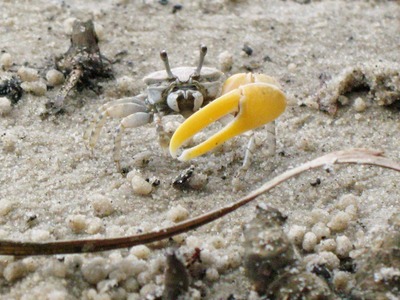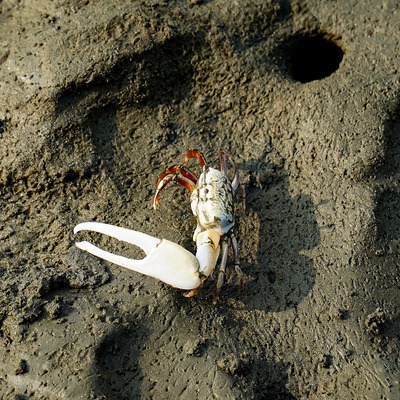FUNCTION
Claw waving is a behaviour observed only in male fiddler crabs. Males wave their claws primarily to attract females during reproductive seasons, but may also respond in a similar way to territorial invasions by other males (How, Zeil, & Hemmi, 2007). In the case of reproduction, the types of waving that males exhibit may be further divided into different categories based on several factors, which will be described below using species-specific examples. Claw waving is a costly behaviour for male fiddler crabs to display because of the time and effort it takes to maintain, but the rewards can be worth the energy expended (Murai, Henmi, Matsumasa, Backwell, & Takeshita, 2022).
To differentiate between waving displays in the contexts of courtship and aggression, the species Austruca perplexa will be examined in more detail, based on a study done by How et al. (2007).
To understand the specific types of claw waving that male fiddler crabs exhibit while participating in courtship behaviour, the species Austruca lactea will be used as an example, using a study completed by Murai et al. (2022).
AUSTRUCA PERPLEXA
Austruca perplexa, the perplexing fiddler crab, is a species found in the Pacific from Japan to eastern Australia (How et al., 2007). Male crabs will display two different types of claw waves: lateral (a side-to-side sweeping motion) and vertical (a rapid up-and-down motion) (How et al., 2007). The contexts in which these waves are used differ.
Male crabs wave their claws laterally during courtship displays so that they might attract females to their burrows. Fiddler crabs are territorial and rarely leave the territory their burrow is situated within; thus, the wide, sweeping range of the lateral claw wave increases the visibility of males for any passing females. Ideally, when a female sees a lateral claw wave in the distance, she will be drawn to the male producing it (How et al., 2007).
In contrast, vertical claw waves are rapid and cover a much smaller visual range. This is because male crabs wave their claws vertically during hostile interactions with other males. The reasons for aggression may vary: territoriality over burrows or competition over females are the primary reasons for interactions between males. In these cases, the crab will quickly wave his major claw up and down—covering only a small distance, as his intended receiver is close by—as if attempting to ward away the offending male (How et al., 2007).
AUSTRUCA LACTEA
Austruca lactea, the milky fiddler crab, is found in the Indo-West Pacific on the mudflats of coastlines, and the peak mating season for this species centres around July and August, at which time females are courted by males (Murai et al., 2022). Male crabs have been observed to wave their major claws in three distinct patterns to participate in courtship: an initial broadcasted wave, a subsequent wave directed at a specific female, and a final courtship wave once the female has been drawn close (Murai et al., 2022).
The initial claw waves produced by male milky fiddler crabs are meant to broadcast their location to passing females, even if the males themselves cannot spot any. These waves are slow and steady in order to preserve energy, given that the chance of a female spotting the wave is never guaranteed (Murai et al., 2022).
Once a male crab catches sight of a passing female, he might change his waving style to a more directed approach. Directed waves are produced at a much quicker rate and therefore take more energy to produce, but the male takes this risk under the assumption that the female is now watching him. Ideally, this claw waving display will draw the female closer to the male and his burrow (Murai et al., 2022).
When a female crab is adequately close to a male and his burrow, the male begins producing extremely rapid courtship claw waves. These—while the most energetically costly—will convey the most information about the male to the female he is courting: this typically includes stamina, though there may be other qualities that a female is searching for (Murai et al., 2022).

